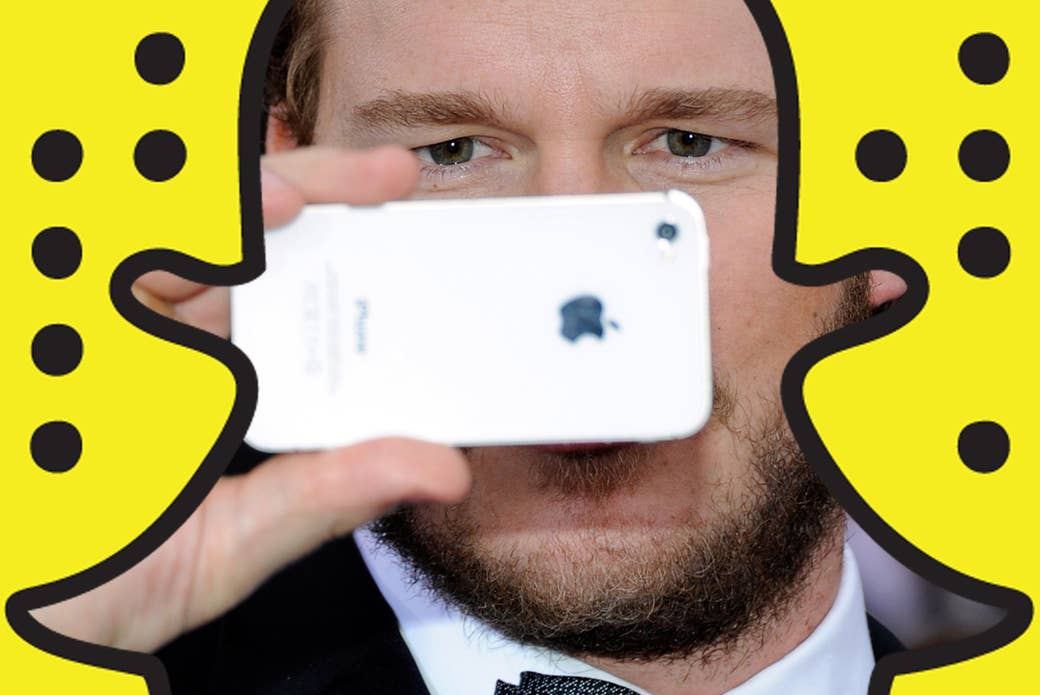
On April 14th, Chris Pratt showed his son Jack The Sound of Music for the first time. Two nights later, Jessica Alba lay awake in bed next to her “effing annoying” husband who only wanted to keep the temperature at “30 below [3 snowflake emojis]” and watch murder TV.
The next morning, Jessica Chastain got her hair done in a bathtub, Reese Witherspoon befriended a dog, and Alba went to a restaurant with her grandparents, where she asked them what it’s like to be married for a million years.
Stars—they’re just like us, right? However, none of these inside scoops came from Us Weekly. Actually, you probably already know how I know the random, intimate details about Jessica Alba’s bedroom life, or what Chris Pratt’s 3-year-old son is up to.
Snapchat.
Over the past six months, the app has flooded with mainstream celebrities. Classic Hollywood actresses like Jessica Chastain, who might never otherwise be caught near a paparazzi, are filming themselves for the world to see, as is Kate Upton, all of the Kardashians, Gwen Stefani, and the freaking United States government. It’s one thing when Diplo is on an app for teens, but times have changed when Reese Witherspoon is right there with him. Snapchat is in the midst of a celebrity invasion and this new landscape is changing both the way the app and its new famous users behave.

But back to Jessica Alba’s bedroom. It was almost too intimate seeing her complain about her husband as he lay silently behind her, face aglow in the blue light of the TV. It was like being in your parents bathroom as they undress and get ready for bed—awkward and inappropriate. It felt like I was violating her privacy, even though she had inadvertently given consent. This is exactly what Snapchat provides that other social media doesn’t. “The whole experience feels much more like you’re peering into a world as opposed to sitting back and having it revealed to you,” says Tania Yuki, founder and CEO of Shareablee, a platform that analyzes social media campaigns. This feels like the real Jessica Alba as she really is, in her real life. “It’s a blurring between peoples public and private personas. It feels like the divide is melting away.”
While Twitter gave celebrities the opportunity to defile their public personas by writing things like "BILL COSBY INNOCENT !!!!!!!!!!", that freedom, for most stars anyway, lasted briefly, or only came at rare moments with rare celebrities. Now Twitter has publicists vetting every word, if not writing everything themselves. Even Instagram, another peek into the lives of the rich and famous, leaves too much room for Photoshop and curation. “Celebs use [Snapchat] more as a look into their everyday life,” says Emily Longeretta, senior entertainment editor at Hollywood Life. On Snapchat, famous people like Kylie Jenner will post about their juice cleanses and car rides, things that no one wants to see or hear about on Twitter. “That's because there's no limit,” Longeretta adds. “You can post a hundred times a day and it won't clog your feed or timeline the way it would on Twitter or Facebook.”
Whereas Twitter and Instagram are like shouting into a noisy room and hoping to be heard above the din, Snapchat is whispering directly into the listener's ear. “It’s hard because as a publicist we’re trained to control and strategically plan content put out by a client,” explains one celebrity publicist who works with a feminist TV star and writer you’ve definitely seen naked. “I try to tell clients not to get too trigger happy when posting.”
But it’s the intimacy of Snapchat that makes it work. We see the celebrity holding their phone, presumably pressing that little circle at the bottom of the screen to record, just as we tap and hold our phones to watch. It’s almost like we’re connected through that act of clicking; Each gripping our phones—the extensions of ourselves—and passing along a message. It’s probably as close as we’ll get to touching Kim Kardashian.
“[snapchat] feels much more like you’re peering
into a world, as opposed to sitting back and having it revealed to you.”
—tania yuki,
founder & Ceo of shareablee
Back in 2011 when Snapchat first launched, tweens immediately understood that basic formula—the only difference is that it was just between friends. You could do anything because it only lasted 10 seconds, at most, and it allowed you to feel like you were right there with each other at any moment. That was the beauty of it, and it took off. A year after its launch, 20 million photos were shared daily. Once middle and high-schoolers signed up in flocks, early adopter celebrities like Diplo joined in to snap behind-the-scenes footage on tour, YouTubers and Vine stars came in to further their internet domination, and Snapchat’s early “artists” like Shonduras (who worked in the medium of elaborate doodles) signed on and were hired by brands like Disney and Taco Bell to snap promotional stories directly to those teens.
But what happened next changed how the rest of the grown world viewed that winking little ghost. DJ Khaled got lost at sea on a jet ski. He live-snapped the adventure, and suddenly the significantly large portion of the population who had never noticed his booming rap anthems were confronted with a 200-plus-pound Floridian DJ in a leather bomber taking a selfie on the cover of Bloomberg Businessweek. The world got curious about his "keys" because he proved that someone could actually go from somewhat recognizable to worldwide attention on the strength of a Snapchat story.
Now, the biggest Hollywood PR firms from Weber Shandwick to Rubenstein and 42West have entire divisions dedicated to social media strategists, and Snapchat is the priority. But “it’s like teaching a celebrity a whole new foreign language,” says Rob Shuster, who was a publicist for stars like Jennifer Lopez, Diddy, and Naomi Campbell before becoming editor in chief of his own gossip blog, Naughty Gossip. “These are people who make their living in movies where there are hundreds of people—lighting, cameras and editors—on set. To have it all in your hand can be quite scary,” he says.
So for most A-listers, the strategy has been to stick to the Hollywood formula. Even their Snapchats remain highly produced. They might be lying in bed, but that’s on 5,000 thread count sheets in a $10,000-per-night room in the Ritz. They probably already have their hair and makeup done. The lighting has been perfected pre-recording. The shots are pretty, inviting, and very boring.
What most mainstream celebrities haven’t grasped is that Snapchat only works when it’s off-the-cuff, like Khaled’s jet ski adventure. On Snapchat, it’s not interesting when Jessica Chastain posts a video looking out the window on her flight to L.A., or even when Kate Upton uses a filter to give herself a dog’s face. We’re all doing that on our own anyway.
In the last week of March, the U.S. government got a Snapchat, and now pays at least two people to look over one phone at every event they’re covering to make sure there aren’t any typos and everything is factually correct. That is not how this is supposed to work. The second a snap looks curated and planned it’s already ruined. Those moments belong on Instagram.
The thing is—and this is what we must remember—celebrities don’t care. It’s just another opportunity for them to constantly re-enter your radar. “Whenever celebrities get involved, it’s a business,” explains Shuster. “It feels more personal, but I don’t think it really is. They don’t want to hang out with you. They’re not doing this because they want to be one big happy family. No. They’re trying to sell you stuff.” Ariana Grande did exactly that the night she released “Let Me Love You.” Instead of even filming herself listening to the song, she snapped a black screen with the text "#BuyLetMeLoveYouOnItunes" for, like, 10 snaps in a row. She might not even have been the one snapping for all we could see.
With that, Snapchat is becoming just the essence of live. Like the rest of social media, it is now manufactured “real.”

On Snapchat, though, even the manufactured real has proven more interesting, with people using the Story feature to make fictional short films in real time. Kylie Jenner, whose entire celebrity status is, arguably, a manufactured story, did this most famously and with the most famous cast (starring Kendall Jenner, Hailey Baldwin, and her friend Harry). But it was actually a Canadian writer and social critic named Alex Kazemi, who teamed up with the Internet-famous InternetGirl to make the first popular Snapchat film under the account @Mudditchgirl91. The film’s character was basically a hyper, sarcastic, and bitchy version of a Grimes-influenced teen girl in 2015, and Kazemi says the aim of the film was to hold up a mirror to social media. He says he wanted to ask, “What is creativity? What is an artist, when everyone who has WiFi/LTE access is one? It's not like anyone who is scrolling through Instagram is actually saying ‘Well, no that weird picture of a slug beside a pocket knife isn't art!’”
The producer Eli Roth had been in touch with Kazemi and made his own Snapchat murder mystery soon after Mudditchgirl91 debuted. Now Parker Posey says she wants to make a movie on the medium, and even the Tribeca Film Festival hosted a Snapchat short film competition this year, judged by…wait for it…DJ Khaled and Jessica Alba.
The company itself is catering to this new celebrity-ruled reality with its Official Stories, quietly rolled out in November. It’s basically the verified of Snapchat, where famous people are able to choose an emoji to go with their name and are much easier to find in the search menu, popping up immediately even if their handles are different than their names. Now that they’re easier to find, more celebrities are more likely to join. In the process, the company’s valuation has ballooned to a massive $16 billion. While Snapchat has Discover, a platform for magazines and newspapers to exist on the app, these Official Stories are giving every celebrity his or her own version of a Snapchat TV show or magazine to be used and updated as they wish.
It's also making the traditional tabloids scramble and change the way they keep up on the lives of celebrities. “When there's a huge story and a celebrity has kept mum on it, we're constantly checking their Snapchat, taking screengrabs and setting up alerts for when certain celebs post,” Longeretta of Hollywood Life says.
It hasn’t happened much just yet, but soon we’ll start seeing things like baby announcements and album release date reveals on there, attempting to entice audience engagement with short-lived posts. The urgent immediacy of it all is built to attract and excite viewers before the video disappears. It might not be as candid as it looks, but it’s definitely less produced than a magazine or even blog announcement that’s gone through layers of editors. Here the celebrity has more control. But also, anyone can become a celebrity. “Now we are all our own paparazzi, and regular Instagram Stars like Snapchat: Mudditchgirl91 are our live entertainment,” Kazemi, the short film director, says. Snapchat is on its way to becoming just another form of a tabloid with the celebrity, and each user, acting as producer and editor in chief.
“I don’t think we should be surprised about this,” says Shuster. It's a cycle: things are cool, people find out about them, they become bigger, there’s more at stake, they get less personal.
The tweens might leave. At the very least, the messages between them will change when they’re up against celebrity stories. It might still be broadcast directly to your phone, but as time goes on, it will feel less and less like a secret whispered into your ear only. Not when celebrities are on there to hawk a product and figure out how to cash in, like Reese Witherspoon recently promoting her clothing line, Draper James.
On March 23, Kourtney Kardashian started posting videos on Snapchat saying that she was in the middle of a “secret photo shoot.” There she was in a robe, getting her makeup done, surrounded by photography equipment. But nothing about this photo shoot was secret—no one would’ve known about it were it not for her incessant snaps. The photo shoot simply would not have existed to anyone else had she not started snapping it, creating her own exclusive, using the app to give more access into her life and trying to make us think we want something that we never even cared about to begin with, that was really neither exclusive nor interesting. It was all a ploy for followers from the least-followed Kardashian. And on top of all that, she saved the video and reposted it to Instagram.
Welcome to the new Snapchat.



